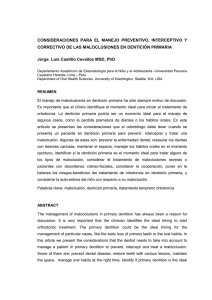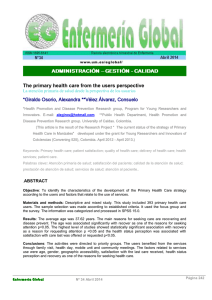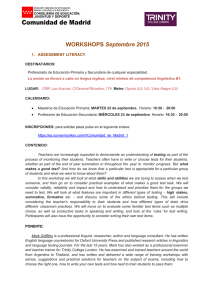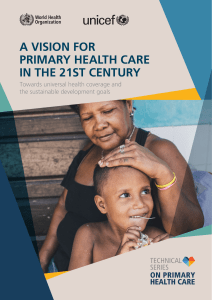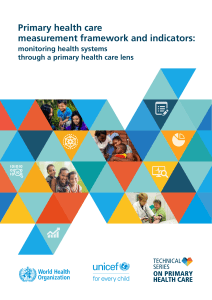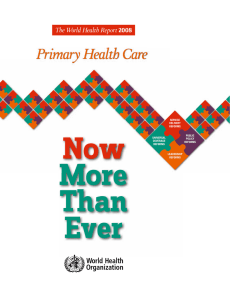A Tool to Evaluate Primary Health Care From the Population
Anuncio
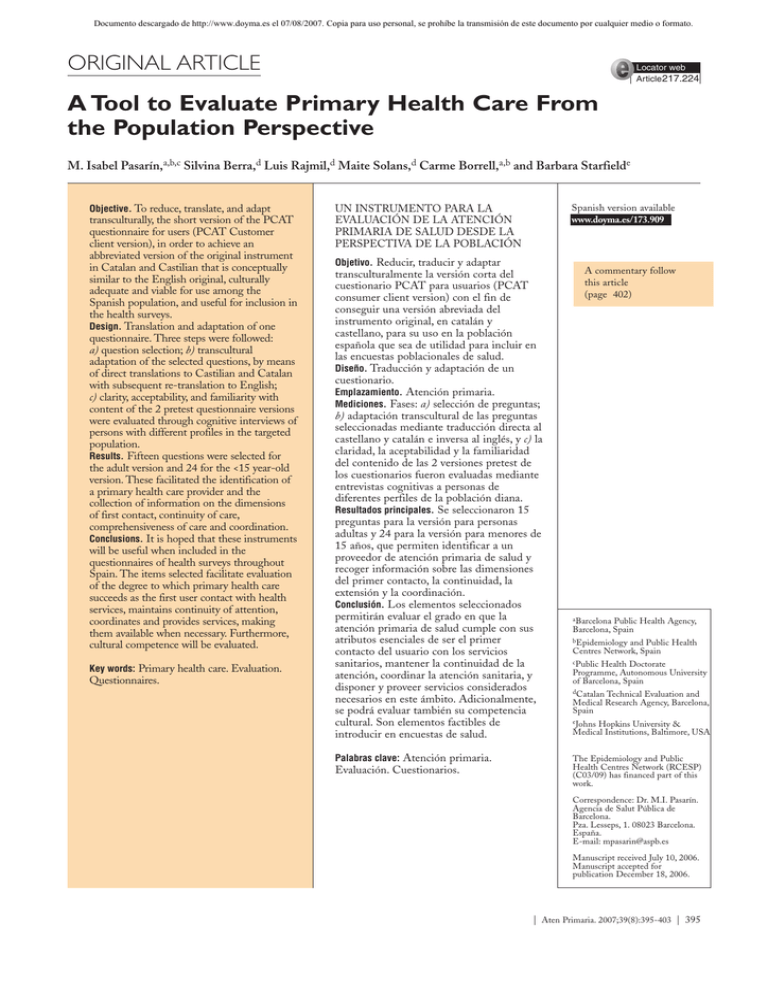
Documento descargado de http://www.doyma.es el 07/08/2007. Copia para uso personal, se prohíbe la transmisión de este documento por cualquier medio o formato. ORIGINAL ARTICLE Locator web Article 217.224 A Tool to Evaluate Primary Health Care From the Population Perspective M. Isabel Pasarín,a,b,c Silvina Berra,d Luis Rajmil,d Maite Solans,d Carme Borrell,a,b and Barbara Starfielde Objective. To reduce, translate, and adapt transculturally, the short version of the PCAT questionnaire for users (PCAT Customer client version), in order to achieve an abbreviated version of the original instrument in Catalan and Castilian that is conceptually similar to the English original, culturally adequate and viable for use among the Spanish population, and useful for inclusion in the health surveys. Design. Translation and adaptation of one questionnaire. Three steps were followed: a) question selection; b) transcultural adaptation of the selected questions, by means of direct translations to Castilian and Catalan with subsequent re-translation to English; c) clarity, acceptability, and familiarity with content of the 2 pretest questionnaire versions were evaluated through cognitive interviews of persons with different profiles in the targeted population. Results. Fifteen questions were selected for the adult version and 24 for the <15 year-old version. These facilitated the identification of a primary health care provider and the collection of information on the dimensions of first contact, continuity of care, comprehensiveness of care and coordination. Conclusions. It is hoped that these instruments will be useful when included in the questionnaires of health surveys throughout Spain. The items selected facilitate evaluation of the degree to which primary health care succeeds as the first user contact with health services, maintains continuity of attention, coordinates and provides services, making them available when necessary. Furthermore, cultural competence will be evaluated. Key words: Primary health care. Evaluation. Questionnaires. Spanish version available www.doyma.es/173.909 UN INSTRUMENTO PARA LA EVALUACIÓN DE LA ATENCIÓN PRIMARIA DE SALUD DESDE LA PERSPECTIVA DE LA POBLACIÓN Objetivo. Reducir, traducir y adaptar transculturalmente la versión corta del cuestionario PCAT para usuarios (PCAT consumer client version) con el fin de conseguir una versión abreviada del instrumento original, en catalán y castellano, para su uso en la población española que sea de utilidad para incluir en las encuestas poblacionales de salud. Diseño. Traducción y adaptación de un cuestionario. Emplazamiento. Atención primaria. Mediciones. Fases: a) selección de preguntas; b) adaptación transcultural de las preguntas seleccionadas mediante traducción directa al castellano y catalán e inversa al inglés, y c) la claridad, la aceptabilidad y la familiaridad del contenido de las 2 versiones pretest de los cuestionarios fueron evaluadas mediante entrevistas cognitivas a personas de diferentes perfiles de la población diana. Resultados principales. Se seleccionaron 15 preguntas para la versión para personas adultas y 24 para la versión para menores de 15 años, que permiten identificar a un proveedor de atención primaria de salud y recoger información sobre las dimensiones del primer contacto, la continuidad, la extensión y la coordinación. Conclusión. Los elementos seleccionados permitirán evaluar el grado en que la atención primaria de salud cumple con sus atributos esenciales de ser el primer contacto del usuario con los servicios sanitarios, mantener la continuidad de la atención, coordinar la atención sanitaria, y disponer y proveer servicios considerados necesarios en este ámbito. Adicionalmente, se podrá evaluar también su competencia cultural. Son elementos factibles de introducir en encuestas de salud. Palabras clave: Atención primaria. Evaluación. Cuestionarios. A commentary follow this article (page 402) aBarcelona Public Health Agency, Barcelona, Spain bEpidemiology and Public Health Centres Network, Spain cPublic Health Doctorate Programme, Autonomous University of Barcelona, Spain dCatalan Technical Evaluation and Medical Research Agency, Barcelona, Spain eJohns Hopkins University & Medical Institutions, Baltimore, USA The Epidemiology and Public Health Centres Network (RCESP) (C03/09) has financed part of this work. Correspondence: Dr. M.I. Pasarín. Agencia de Salut Pública de Barcelona. Pza. Lesseps, 1. 08023 Barcelona. España. E-mail: [email protected] Manuscript received July 10, 2006. Manuscript accepted for publication December 18, 2006. | Aten Primaria. 2007;39(8):395-403 | 395 Documento descargado de http://www.doyma.es el 07/08/2007. Copia para uso personal, se prohíbe la transmisión de este documento por cualquier medio o formato. ORIGINAL ARTICLE Pasarín MI et al. A Tool to Evaluate Primary Health Care From the Population Perspective Introduction rimary health care (PHC) is an area of special importance within the National Health System, as is the case in Spain, since the need to improve the viability, and therefore, the efficiency of the system involves having a PHC setting available that fulfils its function as the entrance portal, with a high problem solving and core capacity, that modulates the use of the rest of the system.1 Starfield defined a theoretical model to which PHC had to comply with, that included some basic features and other associated ones2 (Table 1). One of the main characteristics of this model is that the focus of attention of PHC is directed at the individual, and not at health problems. Spain began PHC reform (PHCR) in 1984, that would enable profound changes to be made in the primary care field following the principles defined in the Alma Ata conference in 1977. Among the reforms that were established by the PHCR included the introduction of medical history which was non-existent in PHC then, the creation of primary care teams (PCT) instead of basically individual work, as well as the lengthening the clinic times for the population. PHCR assigned a very important role to PHC within the health system, which it has taken since then, with better evaluation of its professionals and giving them a greater role in the health system as a whole.3,4 This “new PHC” was adapted to the model defined by Starfield. After these significant and drastic changes in the health system, the need arose to evaluate the service provision process and the impact of its intervention. A positive impact of PHCR has been observed in the system overall in different studies, and improvements in several areas have been highlighted, such as quality of the drug prescription, user satisfaction, the resolution capacity and even, an improvement in the health of the population.3,4 However, in recent evaluations of PHC processes, the lack of information to determine aspects such as accessibility, longitudinality and continuity of care has been highlighted.5,6 There is a need to increase and improve information so that centres can be compared as regards their care capacity, their structure, practice or processes, as well as the product or results of the care.2,7,8 Starfield and Shi, of the Johns Hopkins University, in the United States, have designed a set of tools to evaluate PHC, PCAT (Primary Care Assessment Tools),9 which consists of questionnaires that allow evaluating to what degree PHC fulfils these characteristics. The difference between them is the population to which they have to apply: a) the PHC user population, b) the managers of the PHC resources, and c) PHC providers. The tool directed at PHC users may be suitable for use in a Spanish context, where there is a National Health P 396 | Aten Primaria. 2007;39(8):395-403 | System and where the potential user of the public PHC system is population set, and because the theoretical model for which it has been designed is similar to the Spanish one in its basic characteristics. This questionnaire collects information on the experience of users as regards each of the characteristics of PHC (Table 1) from the identity of a provider. It also includes other sections, such as the type of health care cover, the perceived state of health and sociodemographic characteristics.10 There are 4 versions available, 2 for adults (PCAT-AE; adult edition) and 2 for children (PCAT-CE; child edition), a long version (128 and 121 items, respectively) and a short one (59 and 68 items) in each case. The anticipated length of the original short versions is 20-30 min. The response categories are mainly 4 category Likert type scales. The measurement of the degree of compliance of each characteristic is obtained by calculating the average scores of the responses. The dimensions of the original versions of PCAT have an adequate internal consistency.9-11 Given that PCAT has been designed for use in the United States, a transcultural adaptation is required,12,13 because the language and the health and social environment of that country has significant differences compared to Spain. The carrying out of the Third Catalan-Fifth Barcelona Health Survey in 2006 offered the opportunity to include questions to evaluate PHC, but with a limitation as regards the number of items, which had to be reduced. The objective of the study was to reduce and transculturally adapt the short version of the PCAT questionnaire for users (PCAT consumer client version) with the aim of obtaining an abbreviated version of the original tool, in Catalan and Castilian, conceptually similar to the original in English, culturally appropriate and viable for use in the Spanish population, and which would be useful for inclusion in health population surveys. Methods Selection of Questions The research team, together with the people responsible for the 2006 Catalan Health Survey and the 2006 Barcelona Health Survey and the subsequent communication with the author of the original tool, decided to select a reduced number of questions from the PCAT tool for users (adult and 18 year olds versions), a condition required to enable inclusion in population health surveys. Thus, it was decided to use PCAT-CE as the source of the questions for the questionnaire for the population up to 14 years old and the PCAT-AE for the population ≥15 years. These 2 age groups are similar to the 2 age groups that a specific health survey questionnaire is directed, but at the same time they are the 2 age groups around which the PHC is organised, as less than 14 year olds are seen in paediatrics and the rest in the general medicine clinics. Documento descargado de http://www.doyma.es el 07/08/2007. Copia para uso personal, se prohíbe la transmisión de este documento por cualquier medio o formato. Pasarín MI et al. A Tool to Evaluate Primary Health Care From the Population Perspective ORIGINAL ARTICLE item that they found and the degree of conceptual equivalence with the original, on a Original PCAT Version (in English) scale of 0-10 (0 = no difficulty; maximum equivalence; 10 = maximum difficulty; Selection of Questions minimum equivalence). The items and the response options proposed by the translators Consensus Between Those Responsible for the were systematically reviewed in a meeting with Selection of Wuestions Health Surveys, Research Team, Author of the (English) the research team and the translators, where Theoretical Model and the Tool they commented on the difficulties, and the most suitable alternative was selected as the Transcultural Adaptation first consensus versions of the tool. In the following stage, a back-translation was carried Translation A Direct Translation (Forward Translation) out by a translator whose native language was by 2 Professional Translators English and with a sufficient command of Translation B Castilian and Catalan. The differences between the back-translated version and the original Consensus Meeting Between Research Consensus Version version were evaluated in another meeting Team and Translators between the researchers and the translators, to propose alternative solutions. As a result of Version Back-Translated Reverse Translation (Back-Translation) translation process a pre-test version of the Into English questionnaires was obtained and a report was reviewed by the author (BS) of the original tool. Review of the Translations: Consensus Meeting Between Research Team The clarity, acceptability and familiarity of and Translators content of the two pre-test versions of the Pre-Test Version Report and Review With the Author of the Tool questionnaires were evaluated using cognitive interviews with people of different ages, sex, educational levels, and language (Castilian and Pre-Test (Cognitive Debriefing): Catalan). Firstly, the questionnaire was Pilot Version Interviews With People of Different Ages, Sex, of Questionnaire administered and the time required for this Education Level, and Language part of the interview was monitored. The general opinion on the items of the persons interviewed were recorded, by means of 4 General Scheme of the Study questions on difficulty, understanding and interest of the questions and suitability of the Transcultural Adaptation Process of the PCAT (Primary Care Assessment questionnaire language, which were answered Tools) Questionnaires. using a Likert type scale of 5 options (1 = none; 2 = a little; 3 = moderately; 4 = a lot; 5 = very). Lastly, paraphrasing and probing methods14-15 were used to assess the understanding of the questions by the person interviewed, by means of statements made by the same person to reformulate the The following points were taken into account in the selection of question. The interviewers recorded their opinions, incidences the questions: a) objectives and contrast with the group of and difficulties, as well as suggestions for changes, and these were questions of the health survey, given that it had questions in analysed jointly with the research team, all of which led to other sections that could refer to aspects measured by PCAT for making changes to the questionnaire. At the end of this phase users; b) prioritisation of the PHC attributes measured, due to the final pre-test versions were obtained, for children (≤14 years) the time limit of the interview that would be dedicated to this and adults (≥15 years), in Castilian and Catalan. section; and c) opinion of the author of the theoretical model and the original questionnaire in English (BS) on the process followed. As with the original version, both questionnaires were administered by an interviewer, the questionnaires for children would be answered by an indirect informant, and the adult ones Selection of Questions by the person him/herself. Results Transcultural Adaptation of the Selected Questions The adaptation of the users PCAT versions in Castilian and Catalan were carried out following the method of direct and back-translation recommended in the specialised scientific literature.12,13 Firstly, 2 translators, both with Castilian and Catalan as their mother tongue, and with sufficient command of English, both carried out independent translations into each language. The translators scored the degree of difficulty for each Firstly, it was decided only to evaluate the essential attributes. Fifteen questions were chosen for the adult version and 24 for the children less than 15 years old version, which enabled a PHC provider to be identified and to collect information on the dimensions of first contact, continuity, extent of services, and coordination. The contents of these dimensions and the number of questions for each one compared to their original versions | Aten Primaria. 2007;39(8):395-403 | 397 Documento descargado de http://www.doyma.es el 07/08/2007. Copia para uso personal, se prohíbe la transmisión de este documento por cualquier medio o formato. ORIGINAL ARTICLE Pasarín MI et al. A Tool to Evaluate Primary Health Care From the Population Perspective are shown in Table 2. There are a total of 12 questions in the PCAT-AE and 20 in PCAT-CE, which correspond to the original questionnaire, while 3 and 4 questions, respectively, are additional and respond to the needs of the health survey. In the extent or totality of services, where the availability and provision of certain services, basically preventive were measured, it was considered, on the one TABLE 1 Characteristics of Primary Health Care Defined by Barbara Starfield* hand, that the Spanish health system is public, with a very homogenous service provision, and on the other, that the health questionnaire tool for adults already included preventive activities which are appropriate to PHC (anti-smoking advice, regular blood pressure measurements, influenza vaccination). Only the mental health services item of the PCAT-AE was selected in this dimension. On the other hand, the number of items selected from the child questionnaire (PCATCE) was greater, given that they were not included in other parts of the survey. Adaptation of the Questionnaire No conceptual differences were encountered during the translations. Few difficulties in the style of writing were 2. Continuity: the primary care professional must have the means to be able to offer found. One of them was the English acronym “PCP” continuity in care and carry it out over an extended period of time (primary care provider), which is used in the formulation 3. Cover: PHC must offer complete and extensive care, and not just centred on resolving health problems on demand but, for example, carry out preventive of the majority of questions to refer to the person or place interventions, in response to most prevalent health needs identified as the PHC provider. In this case, a short 4. Coordination: PHC must be coordinated with the rest of the care providers in equivalent phrase had to be agreed upon (Table 3). other health fields During the translation and the consensus meetings other Secondary attributes doubts arose which were recorded for assessment during a) Family approach: it is important to focus health of individuals in the closest social context, that is, the family the pre-test. These included understanding the term b) Community orientation: it is essential to focus care on the resolution of health “appointment slip” or “authorisation,” or “mental health problems of the community that includes the target population services” and “sexual health,” particularly for younger c) Cultural competence: professionals must know how to adapt and establish relationships that will help in the care of health problems of people of different users. There were few specific observations that were social groups of the population assigned different in Castilian and Catalan, and they were of minor *PHC indicates primary health care. significance and easy to resolve. 2 Taken from Starfield B. Later, cognitive interviews were carried out on 19 people of different ages, sex, education level, and language (Table 4). In the child version of the questionnaire, the 5 people TABLE interviewed were mothers, and Dimensions and Number of Items of the Original (United States) and Spanish Versions of the PCAT for Adults (AE-PCAT) and Children (CE-PCAT) 2 in the adult version, the distribution by sex was the same. Number of Questions (+ Additions) The stratum for low education Dimension PCAT-AE PCAT-CE level was only covered in the United States Spain United States Spain version for adults over 40 years. Identification of physician or primary care centre* 5 (+1)† 1 (+3)† 5 (+1)† 1 (+3)† The young adult population First contact: use 3 2 3 2 (including mothers who First contact: access 4 3 4 3 answered the child version) had Continuity of care 4 3 4 3 mainly secondary and university Coordination 1 (+4)‡ 1‡ 1 (+4)‡ 2 (+1)‡ education. Finally, the Castilian Coordination: information systems 3 0 3 0 and Catalan versions were used Provision: services available 4 1 4 4 in a similar proportion. Provision: services provided 5 0 7 3 Observations on the general Family approach 3 0 3 0 aspects of the questionnaire and Community orientation 3 0 3 0 questions specific to the Cultural competence 3 1 3 2 questions asked were recorded Total 42 12+3 44 20+4 during the interview. All the *The questions marked were part of the Catalonian Health Survey-Barcelona Health Survey (ESCAESB) (they are not observations were pertinent for counted in the lateral columns). †The additional questions from the original version measure the degree of loyalty, while the additional questions of the the 2 languages, Castilian and versions adapted for this work referred to characteristics of the provider (type of health care and number of visits made in Catalan. one year to this provider). ‡The first question is a filter from which people jump to if they have not been to a specialist. In the PCAT-AE, this filter As a result of the adaptation has been replaced by a response option. Extended Table in the electronic version. process, 6 minor modifications Essential attributes 1. First contact: PHC must be the health care setting where people establish the first contact for issues relating to their health, except in emergency situations 398 | Aten Primaria. 2007;39(8):395-403 | Documento descargado de http://www.doyma.es el 07/08/2007. Copia para uso personal, se prohíbe la transmisión de este documento por cualquier medio o formato. Pasarín MI et al. A Tool to Evaluate Primary Health Care From the Population Perspective TABLE ORIGINAL ARTICLE (AE) and 5.6 min for the children´s version (CE) (Table Form Ítem Dificulty* Equivalence† 5). The degree of difficulty of the questionnaire, according to Original in English When you have a new health problem, do you go to your PCP before going anywhere else? the opinion of the people Direct translationCuando tiene un problema de salud nuevo, ¿acude usted interviewed, was very low (mean, translator A a su PCP antes de ir a otro sitio? 2 2 1.3), and was less so for the Direct translationCuando tiene usted un nuevo trastorno de salud, ¿va usted translator B a su AP antes de ir a otro lugar? 5 5 mothers of children (mean, 1.2) Consensus versionCuando tiene usted un nuevo problema de salud, ¿va usted and higher for those who direct translation a su médico/médica o centro antes de ir a otro lugar? responded to the adult version Back-translation When you have a health problem, do you go to your doctor (mean, 1.4). The level of or centre before going anywhere else? 1 1 understanding of the questions Consensus version Cuando tiene usted un nuevo problema de salud, ¿va usted a of the back-translation su médico/médica o centro antes de ir a otro lugar? was practically maximum for the Notes from the translators The Acronyms such as PCP in English are not often used in Castilian or Catalan. Also, child version (mean, 4.4) and from the consensus in these languages, it is recommended to use the 2 gender types, particularly in selfmeeting administered versions. This leads to lengthy formulations of the questions that have to be answered by the mothers, and evaluated in cognitive interviews. Find out in the interviews what are the names most used was also high for the adult by the interviewees: physician, doctor, PHC, primary care team, CAP, specialist centre, etc version (mean, 3.9). The level of Pre-test When you have a new health problem, do you go to your doctor or centre before going anywhere else? interest of the questions was, in general, moderate (mean, 3.3), *Difficulty: 0 = no difficulty, 10 = maximum difficulty. †Equivalence: 0 = maximum equivalence, 10 = minimum equivalence. with significant variability in the version for adults (range, 1-5). The suitability of the language was good for the child version and moderate for those who responded to the adult and the modification of 1 item (A8) have been version. proposed among the 24 items translated for the children´s version (CE), and 4 minor modifications among the 15 items translated for the adult population (AE). All the minor modifications consisted of grammatical points to make it easier to formulate and understand the questions. A group of variables have been obtained to evaluate PHC The proposed modification to item AB was not due to a from the perspective of the population to whom the translation problem, but to the difficulty of the people service is offered, from the ESCA-ESB and the PCAT interviewed to respond, without a time limit, to the questionnaire for the adult (PCAT-AE) and child (PCATquestion “How many times in total have you been there CE, for indirect informants) population, based on (their doctor or PHC centre)?,” as the question was set in a theoretical model that establishes the essential the original questionnaire. The modification was the characteristics that PHC has to fulfil. This work presents introduction of a reference time period of one year. This the process of selecting the items and the cultural implied that it became an indicator of the use of the adaptation of the questionnaires. services and not of loyalty to a service. It is hoped that these tools will be useful for inclusion in As regards the viability of the use of the questionnaire, it health surveys in the Spain. For this reason, the least required, on average 5.2 min to complete the adult version number of items possible was selected that would be 3 Resultados de la traducción y adaptación de un ítem del instrumento PCAT-usuarios para personas adultas (AE) para la versión en castellano Discussion TABLE 4 Number of People Interviewed for the Pre-Test Versions in Castilian or Catalan of the Users PCAT, According to the Person Interviewed, Sex, Education Level, and Language PCAT Version,* Age Range Interview† Age, years Sex Mean Range Female CE, 0-14 Informant 38.0 35-41 5 AE, 15-39 Direct 22.6 16-36 2 AE, 40-69 Direct 50.8 47-55 2 AE, ≥70 3 Direct 76.0 70-82 2 11 Education Level‡ Male Language Primary Secondary University Castilian Catalan Total 1 3 1 3 2 5 5 1 2 3 4 3 3 3 2 3 1 3 2 5 1 1 8 19 2 8 6 8 5 11 *PCAT version: CE indicates child edition; AE, adult edition. †People interviewed: directly with the person or through an indirect informant, in the case of the child questionnaire. ‡In the questionnaire for adolescents the higher level between mother and father was recorded. | Aten Primaria. 2007;39(8):395-403 | 399 Documento descargado de http://www.doyma.es el 07/08/2007. Copia para uso personal, se prohíbe la transmisión de este documento por cualquier medio o formato. ORIGINAL ARTICLE TABLE Pasarín MI et al. A Tool to Evaluate Primary Health Care From the Population Perspective by using other types of questions that record the statement that PCAT Version† CE AE Total the person may have received certain preventive practices. The Administration time, min 5.6 5.2 5.3 reduction in items affected the Have the questions been difficult to answer? 1.2 1.4 1.3 Have you been able to understand the questions? 4.4 3.9 4.0 adult version more than the child Did you find the contents of the questions interesting? 3.4 3.3 3.3 one, given that the dimensions Did the language and the style of the questionnaire seem suitable for you? 3.8 3.1 3.3 are made up of 1-4 items. In later evaluations of the tool, by means *Average times in minutes and scores on a 5 options Likert type scale (1 = none; 2 = a little; 3 = moderate; 4 = a lot; 5 = very) for the remaining questions. of a pilot study, the validity and †PCAT version: CE indicates child-edition; AE, adult edition. reliability of the dimensions will be analysed, using the means calculated from the items that make up each dimensions, capable of collecting the dimensions of the theoretical as was used in the original questionnaire, to compare its model that were considered priorities, taking into account operation with the version with a higher number of items. the context of the Spanish National Health System and Despite the limitation of reliability which this reduced the background information that is already collected in number of items may assume, it is hoped to have a tool these health surveys. The items thus selected would allow with acceptable measuring properties and a number of the degree to which PHC fulfils these essential attributes questions that will ensure its viability in long term studies. to be evaluated, such as, being first contact with the health As a result of the pre-test, the questionnaire, in general, services for the user, maintaining continuity of care, was not difficult, was understandable, sufficiently coordinating health care and carrying out and providing interesting and with a good adaptation of the language. services considered necessary in this care setting. The pre-test was useful for introducing some Additionally, its cultural competence will also be able to be modifications that were expected to improve the evaluated. It must be pointed out that these versions do consistency of the questions in the questionnaire. not collect all the dimensions included in the original tool, A systematic process of translation and adaptation was and have fewer items. The dimensions not included are, carried out, which is line with international standards and family and community orientation, in both questionnaires, enables problems of linguistic and semantic differences to and the services provided by the version for adults. This resolved, as well as familiarity with terms and concepts in last dimension is normally included in health surveys, but a cultural context; in this case the organisation of the health system. The consensus meeting between the researchers and the translators, the cognitive tests with people from the target population and the review of the process by the author of What Is Known About the Subject the theoretical model and the tool, ensure that versions obtained will include words and questions understood by A long process of reform of primary health care the end-users of the questionnaire, and helped in (PHC) has ended in Spain. validating its contents by measuring the characteristics This has brought about important changes in the that PHC is supposed to fulfil. provision of primary care services. PHC is currently being evaluated using the information available, a fact that has led to deficiencies being detected There are areas of evaluation for which there are for evaluating areas such as continuity and coordination of no evaluation tools for application in our care. The PCAT user versions with the questions in country. Castilian and Catalan will provide another tool for evaluating PHC and will include new aspects in the What This Study Contributes evaluation, in the context of the Spanish and Catalonian The methodology followed to obtain a group of health system. Also, by not just including the provisions items suitable for evaluating some essential available in the evaluation, but also the provisions attributes of PHC from the perspective of the perceived by potential users, it must be able to detect areas population. for improvement, such as, accessibility to services. The perspective of the population is essential in the evaluation These items can be easily included into wider of all fields of the health system, but in the case of PHC it health surveys that are carried out systematically. acquires even more importance due to its coverage, since 70% of the population go to primary care clinics in one year.16 5 Feasibility of the PCAT Questionnaire: Administration Time and Opinions of the People Interviewed on the Difficulty, Understanding, Interest, and Suitability of the Language of the Questionnaire. Averages* • • • • • 400 | Aten Primaria. 2007;39(8):395-403 | Documento descargado de http://www.doyma.es el 07/08/2007. Copia para uso personal, se prohíbe la transmisión de este documento por cualquier medio o formato. Pasarín MI et al. A Tool to Evaluate Primary Health Care From the Population Perspective The main limitation of this process is that a translation and adaptation of the complete original tool could not be carried out, which implies that the evaluation that was made on PHC did not cover the theoretical model in its entirety. Also, by not being able to include complete dimensions, the measurement obtained will not have the same validity as the original tool. Even so, it is considered an important step to have made this reduced version available, since it could be included in the principal health surveys that are carried out in Spain in several environments (municipalities, autonomous communities, national). The questionnaires presented here will be included in ESCA 2006 and in the 2006 Barcelona Health Survey. These are the first of a group that it is hoped will be available in the medium term, given the recognised need to have tools available to evaluate the fulfilment of the dimensions of PHC from the perspective of those for whom the services are provided, the managers and providers of PHC. A new project has been started recently, financed by the Health Research Fund, which will enable the Castilian and Catalan PCAT versions to be adapted for PHC providers. Acknowledgement We would like to thank the management of the Third Catalonian Health Survey-Fifth Barcelona Health Survey of 2006, for being the driving force for carrying out this work. References 1. Villalbí JR, Farrés J. Culminar la reforma de la atención primaria de salud: gestión del cambio en Barcelona, 1998-2003. Aten Primaria. 2005;35:484-8. 2. Starfield B. Atención primaria. Equilibrio entre necesidades de salud, servicios y tecnología. Barcelona: Masson; 2001. ORIGINAL ARTICLE 3. Villalbí JR, Guarga A, Pasarín MI, Gil M, Borrell C, Ferran M, et al. Evaluación del impacto de la reforma de la atencion primaria sobre al salud. Aten Primaria. 1999;24:468-74. 4. Ris H, Pané O. La reforma de l´atenció primària de salut després d’una dècada. Fulls Econòmics. 1997;30:7-11. 5. Plaza Tesías A, Zara Yahni C, Guarga Rojas A, Farrés Quesada J. Resultado de la aplicación del benchmarking en los equipos de atención primaria de Barcelona. Aten Primaria. 2005;35:122-9. 6. Plaza Tesías A, Guarga Rojas A, Farrés Quesada J, Zara Yanhi C, en representación de los miembros del Grupo Asesor. Consenso sobre un proceso de benchmarking en la atención primaria de salud de Barcelona. Aten Primaria. 2005;35:130-9. 7. Villalbí JR, Pasarín MI, Montaner I, Cabezas, Starfield B y Grupo de Trabajo sobre Evaluación en la Atencion Primaria de Salud de Barcelona. Evaluación de la Atencion Primaria. Aten Primaria. 2003;31:382-5. 8. Sans-Corrales M, Rujol-Ribera E, Gené-Badia J, Pasarín-Rua MI, Iglesias-Pérez B, Casajuana-Brunet J. Family medicine attributes related to satisfaction, health and costs. Fam Pract. 2006;23:308-16. 9. Shi L, Starfield B, Xu J. Validating the adult primary care assessment tool. J Fam Pract. 2001;50:161. 10. Starfield B, Shi L. Manual for the primary care assessment tools. Baltimore: Johns Hopkins University; 2002. 11. Cassady CE, Starfield B, Hurtado MP, Berk RA, Nanda JP, Friedenberg LA. Measuring consumer experiences with primary care. Pediatrics. 2000;105:998-1003. 12. Beaton DE, Bombardier C, Guillemin F, Ferraz MB. Guidelines for the process of cross-cultural adaptation of self-report measures. Spine. 2000;25:3186-91. 13. Scientific Advisory Committee of the Medical Outcome Trust. Assessing health status and quality-of-life instruments: attributes and review criteria. Qual Life Res. 2002;11:193-205. 14. Forsyth BH, Lessler JT. Cognitive laboratory methods: a taxonomy. In: Biemer P, Groves R, Lyberg L, Mathiowetz N, Sudman S, editors. Measurement errors in surveys. New York: Wiley; 1991. p. 393-418. 15. Conrad F. Verbal reports are data! A theoretical approach to cognitive interviews. 2003 [en línea] [acceded Sept 17, 2003]. Available from: http://www.fcsm.gov/99papers/conrad1.pdf 16. Cabezas-Peña C, Robledo de Dios T, Marqués F, Ortega Sánchez-Pinilla R, Nebot-Adell M, Megido-Badía MJ, et al. Recomendaciones sobre el estilo de vida. Aten Primaria. 2005;36 Suppl 2:27-46. | Aten Primaria. 2007;39(8):395-403 | 401
